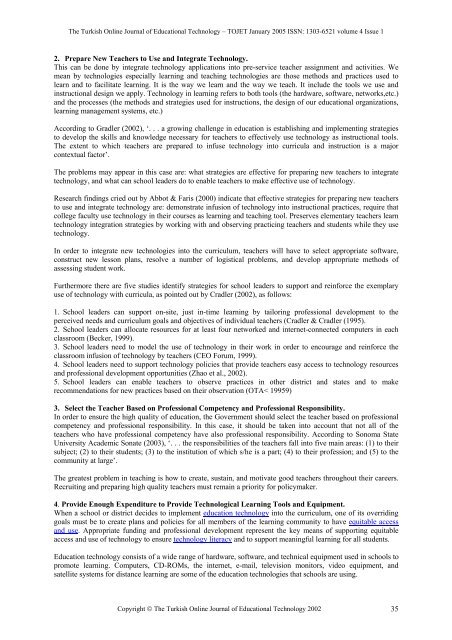Age - TOJET the Turkish online journal of educational technology
Age - TOJET the Turkish online journal of educational technology
Age - TOJET the Turkish online journal of educational technology
Create successful ePaper yourself
Turn your PDF publications into a flip-book with our unique Google optimized e-Paper software.
The <strong>Turkish</strong> Online Journal <strong>of</strong> Educational Technology – <strong>TOJET</strong> January 2005 ISSN: 1303-6521 volume 4 Issue 1<br />
2. Prepare New Teachers to Use and Integrate Technology.<br />
This can be done by integrate <strong>technology</strong> applications into pre-service teacher assignment and activities. We<br />
mean by technologies especially learning and teaching technologies are those methods and practices used to<br />
learn and to facilitate learning. It is <strong>the</strong> way we learn and <strong>the</strong> way we teach. It include <strong>the</strong> tools we use and<br />
instructional design we apply. Technology in learning refers to both tools (<strong>the</strong> hardware, s<strong>of</strong>tware, networks,etc.)<br />
and <strong>the</strong> processes (<strong>the</strong> methods and strategies used for instructions, <strong>the</strong> design <strong>of</strong> our <strong>educational</strong> organizations,<br />
learning management systems, etc.)<br />
According to Gradler (2002), ‘. . . a growing challenge in education is establishing and implementing strategies<br />
to develop <strong>the</strong> skills and knowledge necessary for teachers to effectively use <strong>technology</strong> as instructional tools.<br />
The extent to which teachers are prepared to infuse <strong>technology</strong> into curricula and instruction is a major<br />
contextual factor’.<br />
The problems may appear in this case are: what strategies are effective for preparing new teachers to integrate<br />
<strong>technology</strong>, and what can school leaders do to enable teachers to make effective use <strong>of</strong> <strong>technology</strong>.<br />
Research findings cried out by Abbot & Faris (2000) indicate that effective strategies for preparing new teachers<br />
to use and integrate <strong>technology</strong> are: demonstrate infusion <strong>of</strong> <strong>technology</strong> into instructional practices, require that<br />
college faculty use <strong>technology</strong> in <strong>the</strong>ir courses as learning and teaching tool. Preserves elementary teachers learn<br />
<strong>technology</strong> integration strategies by working with and observing practicing teachers and students while <strong>the</strong>y use<br />
<strong>technology</strong>.<br />
In order to integrate new technologies into <strong>the</strong> curriculum, teachers will have to select appropriate s<strong>of</strong>tware,<br />
construct new lesson plans, resolve a number <strong>of</strong> logistical problems, and develop appropriate methods <strong>of</strong><br />
assessing student work.<br />
Fur<strong>the</strong>rmore <strong>the</strong>re are five studies identify strategies for school leaders to support and reinforce <strong>the</strong> exemplary<br />
use <strong>of</strong> <strong>technology</strong> with curricula, as pointed out by Cradler (2002), as follows:<br />
1. School leaders can support on-site, just in-time learning by tailoring pr<strong>of</strong>essional development to <strong>the</strong><br />
perceived needs and curriculum goals and objectives <strong>of</strong> individual teachers (Cradler & Cradler (1995).<br />
2. School leaders can allocate resources for at least four networked and internet-connected computers in each<br />
classroom (Becker, 1999).<br />
3. School leaders need to model <strong>the</strong> use <strong>of</strong> <strong>technology</strong> in <strong>the</strong>ir work in order to encourage and reinforce <strong>the</strong><br />
classroom infusion <strong>of</strong> <strong>technology</strong> by teachers (CEO Forum, 1999).<br />
4. School leaders need to support <strong>technology</strong> policies that provide teachers easy access to <strong>technology</strong> resources<br />
and pr<strong>of</strong>essional development opportunities (Zhao et al., 2002).<br />
5. School leaders can enable teachers to observe practices in o<strong>the</strong>r district and states and to make<br />
recommendations for new practices based on <strong>the</strong>ir observation (OTA< 19959)<br />
3. Select <strong>the</strong> Teacher Based on Pr<strong>of</strong>essional Competency and Pr<strong>of</strong>essional Responsibility.<br />
In order to ensure <strong>the</strong> high quality <strong>of</strong> education, <strong>the</strong> Government should select <strong>the</strong> teacher based on pr<strong>of</strong>essional<br />
competency and pr<strong>of</strong>essional responsibility. In this case, it should be taken into account that not all <strong>of</strong> <strong>the</strong><br />
teachers who have pr<strong>of</strong>essional competency have also pr<strong>of</strong>essional responsibility. According to Sonoma State<br />
University Academic Sonate (2003), ‘. . . <strong>the</strong> responsibilities <strong>of</strong> <strong>the</strong> teachers fall into five main areas: (1) to <strong>the</strong>ir<br />
subject; (2) to <strong>the</strong>ir students; (3) to <strong>the</strong> institution <strong>of</strong> which s/he is a part; (4) to <strong>the</strong>ir pr<strong>of</strong>ession; and (5) to <strong>the</strong><br />
community at large’.<br />
The greatest problem in teaching is how to create, sustain, and motivate good teachers throughout <strong>the</strong>ir careers.<br />
Recruiting and preparing high quality teachers must remain a priority for policymaker.<br />
4. Provide Enough Expenditure to Provide Technological Learning Tools and Equipment.<br />
When a school or district decides to implement education <strong>technology</strong> into <strong>the</strong> curriculum, one <strong>of</strong> its overriding<br />
goals must be to create plans and policies for all members <strong>of</strong> <strong>the</strong> learning community to have equitable access<br />
and use. Appropriate funding and pr<strong>of</strong>essional development represent <strong>the</strong> key means <strong>of</strong> supporting equitable<br />
access and use <strong>of</strong> <strong>technology</strong> to ensure <strong>technology</strong> literacy and to support meaningful learning for all students.<br />
Education <strong>technology</strong> consists <strong>of</strong> a wide range <strong>of</strong> hardware, s<strong>of</strong>tware, and technical equipment used in schools to<br />
promote learning. Computers, CD-ROMs, <strong>the</strong> internet, e-mail, television monitors, video equipment, and<br />
satellite systems for distance learning are some <strong>of</strong> <strong>the</strong> education technologies that schools are using.<br />
Copyright © The <strong>Turkish</strong> Online Journal <strong>of</strong> Educational Technology 2002 35
















